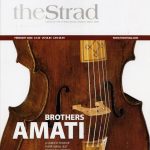The Strad magazine, November 2006 issue: Small change
Copyright © 2006 Alberto Giordano – The Strad magazine. All rights reserved
There is a sense in Italy today that many treasures from the past are alive and hidden, or covered with dust. From the tombs and ruins of Roman civilisation to the secret tunnels of the Baroque age and the lofts of some far-flung country mansion, one can easily imagine that there is always something to discover and rescue. It is intriguing that these objects can be perfectly preserved against the ravages of time if left undisturbed in a safe place.
Finding an item in such a condition can be invaluable for the study and understanding of our past. The quest for fine and rare instruments has flourished in the last 200 years. As a result of this, and the changes that have occurred in the violin field, a part of Italy’s instrument heritage has been transformed.
The evolution of playing technique, and natural wear and tear has caused instruments to lose an important part of their original look. Fittings were removed, necks cut off, belly and upper blocks mortised and varnishes were polished. Additionally, the repair work undertaken to rectify common and inevitable defects has often been very intrusive. These alterations have impoverished our understanding of classical violin making. A small viola, made by Genoese maker Paolo Castello, seems to have avoided this fate. It lay untouched in a loft for some 200 years.
One can imagine that in 1778, the year it was made, an unknown viola player entered Castello’s shop and left with this instrument, and the case and bow. Perhaps he played the viola during his life and when he died the family put the case and its contents in the loft, where it remained until its discovery around six years ago. Paolo Castello is the most renowned Genoese maker of the second half of the 18th century. There is little information concerning his life, and even the dates of his birth and death are unknown.
Details of his training are uncertain and there is a possibility that he was self-taught, as his work differs from the models of other Genoese makers. In particular, it is difficult to draw any parallels with Bernardo Calcagno, the pre-eminent maker in Genoa at that time, who worked with different models and used an attractive oil varnish.
Castello worked solely with his own models and produced two kinds of instruments: the first features handsome wood and more refined workmanship, while the second model was probably used for more run-of-the-mill instruments, based on the fast workmanship and the plain wood used.
His output was consistent and resulted in a good number of violins, violas and cellos over a period of about three decades. This viola was made when Castello’s production was at its peak; there was significant demand for new instruments in Genoa at that time.
Accessories
The coffin-shaped case is made of pine and lined with a basic cotton cloth and the outside is finished in a similar style to traditional Genoese doors and cabinets: a light grey–green water-based paint has been applied directly to the wood and then gently finished with some brushstrokes and a layer of shellac in order to create an antiqued ‘fake marble’ look.
The bow that accompanies the instrument is quite a bizarre object but it is an interesting example of a simple Italian bow of that period: the octagonal stick is made of pearwood, with a boxwood frog and a button made of ebony, without any wrapping to protect the stick. The original pegs and button, fingerboard, neck, bass-bar and the original graduations are all perfectly preserved.
Only the bridge, tailpiece and key to the case are missing from the original set-up. An instrument in such a pure condition is an ideal tool for developing the understanding of the old Italian making technique and, in spite of minor differences, it seems to confirm the basic theories of Roger Hargrave and John Dilworth on old Cremonese working processes.
The rib structure
The viola is made with an internal mould. This is not immediately evident as the ribs do not always run parallel to the edge contour. The upper and lower block slots were extremely large. Unlike the Cremonese mould that had nearly square centre block slots, this Genoese mould seems to have had slanted cut slots.
The upper and lower blocks are of pine and the central blocks are of lime, a common local wood that is soft and easy to work. The curves are not very prominent in order to make the bending process easier. The maple sides (the upper and the lower of one piece) were planed with a rabot blade, finished with rasp and scraper and bent with a hot iron tool with a very slight curve.
In this picture, taken (relate it to positioning of picture in layout) with a wood lamp, it is possible to see near the upper central block on the rib, a horizontal line of glue that dripped along the side marking the edge of the internal mould. The beechwood linings were glued before the extraction of the mould on the back only and they were not mortised to the corner blocks but simply leant against them.
They were gently worked with a small flat gouge and a scraper, while the ones on the belly side are more roughly cut: they were probably glued and worked after the back had been glued to the sides.
The head
Paolo Castello’s heads are always easy to recognise because of the particular and personal drawing of the outline, showing the side view of the pegbox with a sharp end and a flat curve at the throat.
The pegholes are opened in a Neapolitan style, with the middle pegs (second and third strings) set quite far from each other. The fluting of the front and the back was made before cutting the chamfer and it shows careful workmanship; some gouge marks at the bottom are still visible. On the sides one can see that the chamfer has been cut with a chisel and the scoop of the turns cut with a small, curved gouge and then finished with sandpaper.
The same gouge was used to undercut the turns: the front view of a Genoese scroll is always quite bulbous due to the large ears, the undercutting and the final rounding action.
When the head was finished, the joint with the rib structure was removed from the mould. It seems likely that the fingerboard was prepared in order to help the centering of the neck and the height of the neck projection, but not yet permanently glued to it. After the neck was glued to the upper block it was securely nailed to it: in this case Castello used only two nails, but they were of a good strength and quality.
From the bumps left by the hammer on the upper corner block near the nails, it is evident that the nailing action was quite tough. The neck and the sides were then ready to be planed and fixed to the back.
The back
The most noticeable difference from the Cremonese making system in this Genoese viola is the tracing and the drawing of the plates. In Cremona the contour of the instrument was traced from the rib’s outline, but in this case it seems from the lack of cohesion between the back’s edges and the ribs that the back was previously drawn and sawn.
There isn’t any centre pin to fix the back and there is no evidence of any scribed line in the back. In the corners the ribs are glued slightly over the rounding of the edges and the ribs seem to be lightly forced to be parallel with the outline. The outlines of the front and the back are very close together and precisely worked: it seems very likely that a template was used to draw the plates with the borders.
The arching of this small viola back is quite full in the central area and it becomes more hollow while descending towards the borders. The height is 18.5mm; it was worked with a wide gouge and then finished with scraper and sandpaper. In spite of a very light graduation of the plate (3.2–2mm), it shows neat curves and clean workmanship; the inner contact plane for the ribs and the blocks is reduced to the minimum and in a few points an airspace indicates that the contact is not even, in particular in the head block area.
When the back was finally glued to the sides, the linings were glued on the belly side and the blocks were finished: the upper block was roughly split and the others were more gently worked with a gouge.
The front
After Castello sawed the neck rebate he set the rough upper end of the belly on to it. This end does not have a square side and it seems that this piece of wood was barely long enough to fit this viola, since a little shim of wood was added to fit the rebate. Two large maple pins fix the front to the structure.
It is possible that at this stage the fixing of the belly would have aided the neck projection set-up, by simply adding tension to the entire structure in order to get close to the requested height. As with other old-style fingerboards, this one has a further shim that was probably added for the final adjustment. Made from a strong-grain spruce, the belly shows a consistent arching (height 21mm) which is nicely carved and finished with a scraper only – the action is very even and as a result the white grain is slightly higher then the dark grain, which appears well marked in every point.
The f-holes are typical of Castello’s work in terms of the distinctive drawing and the quick work of the knife; wings are subtly fluted with the scraper, the nicks are opened with two resolute knife strokes and the upper holes and wings gently chamfered.
The inside shows a skilful carving action: after the gouge work, the graduations were finished with a scraper and abrasive paper. Thickness is much more consistent than for the back: graduation of the chest area is about 3.8–3.5mm and only decreases below 3mm in the lower parts of the upper and lower bouts. The original bass-bar is taken from the same piece of spruce as the belly, with the grain running in the same direction.
It is placed 1mm inside from the upper hole of the f-hole and consistently slanted. The maximum height of the bass-bar is 7.8mm (on the geometric centre of the instrument), with a length of 285mm. The thickness varies from 5.3mm in the lower end up to 6mm in the upper end.
The final shape is quite straight and well-rounded on the flanks and it is tapered away at the ends. The tap-tone of belly (length 383mm, weight 98.5grams) with the bass-bar has an approximate intonation of E sharp.
The Edgework
When the belly was finished the soundbox was closed and then the instrument was ready for the edgework. It is difficult to ascertain at what stage the edges were worked before the closing of the instrument, but it is evident that the inner side of the borders were perfectly rounded with a file, indicating that the contour was nearly ready. Castello tended to use purflings made of beechwood with the ‘black’ stained with a deep brown colour.
The purflings are consistent in thickness (about 2mm) and are set at 3.5mm from the edge of the border; the points don’t have any bee sting or extension. The purflings run in the front continuously from corner to corner in the lower bout: the lower capo is set just below the purflings, leaving a pleasant impression of continuity; the joints of the ‘stripes’ do not coincide and in many places they are not perfectly glued together, suggesting that they were glued separately. The cutting of the channel, the insert of the purflings and the scoop were made with great care and confidence.
The scoop is of medium depth and it was finished with a scraper: sandpaper was used only to smooth the final rounding of the borders.
The Finishing
The rounding of the edges coincided with the finishing of the button and the shaping of the neck. It is evident that the neck projection was determined in two steps, as a correction to the fingerboard has been made to raise the neck projection a little. This is not unusual: when setting the neck on the ribs, it is difficult to be precise since the back is not yet glued, the belly is just a rough board and the height and centering are done with a certain level of approximation.
The fingerboard was made with a piece of limewood covered with a veneer of Jacaranda, a Brazilian wood commonly used by cabinet makers; the length is 250mm, which is close to five-sevenths of the string length.
Unfortunately the original tailpiece and bridge have been lost, but the viola retains its original jujube wood pegs. From the notches on the upper capo it seems that the player preferred heavy-gauge gut strings.
The varnish
The front was finished with the scraper only, while the rest was sanded. The ground laid all over the instrument is of a delicate colour that has a light grey–green hue when examined in daylight. It is reminiscent of a Neapolitan ground although in this case the oxidation of the wood is less aggressive. A spirit varnish has been used. In the second half of the 18th century, the old oil varnish was abandoned for faster and probably cheaper spirit varnish in many Italian towns.
Castello had previously opted for an oil varnish similar in texture to the one used by Calcanius, but as soon as the demand for new instruments increased he opted for a faster solution. In this viola the varnish is carefully layered with a brush and gently polished: the original deep yellow–orange colour has faded to a more delicate tonality.
The viola today has a generous sound with a particularly brilliant C string: the sound is even and well-balanced across the whole four strings, with a warm and rich tone.
It is unexpected from a small size viola fitted with old gut strings that have not been played for centuries.
Perhaps this viola shows that the alterations made to classic instruments were, if not unnecessary, not always as beneficial to the instruments as was previously believed.
The Strad, november 2006





